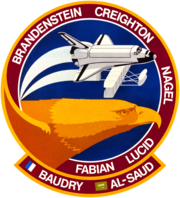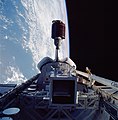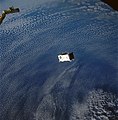STS-51-G
This article includes a list of references, related reading, or external links, but its sources remain unclear because it lacks inline citations. (May 2008) |
| COSPAR ID | 1985-048A |
|---|---|
| SATCAT no. | 15823 |
| End of mission | |

 | |
STS 51-G was the eighteenth flight of a space shuttle, and the fifth flight of Discovery. The mission launched from Kennedy Space Center, Florida, on 17 June 1985. Sultan Salman Al Saud of Saudi Arabia was on board as a payload specialist.
Crew
| Position | Astronaut | |
|---|---|---|
| Commander | Daniel C. Brandenstein Second spaceflight | |
| Pilot | John O. Creighton First spaceflight | |
| Mission Specialist 1 | Shannon W. Lucid First spaceflight | |
| Mission Specialist 2 | John M. Fabian Second spaceflight | |
| Mission Specialist 3 | Steven R. Nagel First spaceflight | |
| Payload Specialist 1 | Patrick Baudry, CNES Only spaceflight | |
| Payload Specialist 2 | Sultan Salman Al Saud, Only spaceflight | |
| Al Saud became the first member of royalty to fly in space | ||
Backup crew
| Position | Astronaut | |
|---|---|---|
| Payload Specialist 1 | Jean-Loup Chrétien, CNES | |
| Payload Specialist 2 | Abdulmohsen Al-Bassam, | |
Mission parameters
- Mass:
- Orbiter Liftoff: 256,524 pounds (116,357 kg)
- Orbiter Landing: 204,169 pounds (92,610 kg)
- Payload: 38,096 pounds (17,280 kg)
- Perigee: 219.5 miles (353.3 km)
- Apogee: 220.5 miles (354.9 km)
- Inclination: 28.5°
- Period: 91.8 min
Mission highlights
The Orbiter Discovery lifted off from Pad A, Launch Complex 39, KSC, at 7:33 a.m. EDT on 17 June 1985. The largest items of cargo were three communications satellites. Also flown were the deployable/retrievable Spartan 1, six Getaway Special canisters, a High Precision Tracking Experiment (HPTE) for the Strategic Defense Initiative ("Star Wars"), a materials processing furnace, and French biomedical experiments. All three communications satellites were successfully deployed and turned over to their owner-operators. Their PAM-D perigee booster motors fired and all three reached geosynchronous orbit, where they entered checkout operations. Spartan 1 was deployed and recovered. All the experiments were successfully accomplished. Discovery landed at Edwards AFB at 9:12 a.m. EDT on 24 June 1985, after a mission duration of 7 days, one hour, 38 minutes and 52 seconds.
The crew members were Daniel C. Brandenstein, commander; John O. Creighton, pilot; Shannon W. Lucid, Steven R. Nagel, and John M. Fabian, mission specialists; and Patrick Baudry, France, and Prince Sultan Salman Al Saud, Saudi Arabia, payload specialists. deployed were the Arabsat 1-B (Arab Satellite Communications Organization); Morelos I (Mexico); and Telstar 3-D (AT&T). All three utilized PAM-D booster stages to achieve geosynchronous transfer orbits after deployment from the Discovery. The latter two spacecraft are variants of the Hughes-built HS-376 series of spin-stabilized satellites. Both use the Morton Thiokol Star 48 motor to circularize the orbit and align it with the equator at apogee. Morelos I provides 12 channels operating in the C-band and 6 channels operating in the Ku band. It can provide educational and commercial television programs, telephone and facsimile services, and data and business transmission services to even the most remote parts of Mexico. Telstar 3-D operates in the C-band only, and has 24 working channels. Using single sideband technology, a Telstar can relay up to 86,400 two-way telephone calls. Both spacecraft are about 22 feet (6.7 m) high and 7 feet (2.1 m) wide when deployed, and have a mass of around 1,300 pounds (590 kg) when operational.
Arabsat 1 satellites are built by an international team led by Aerospatiale of France. It is a three-axis stabilized spacecraft with two deployable solar array wings, making it almost 68 feet (21 m) long and over 18 feet (5.5 m) wide when deployed in orbit. It weighs about 2,800 pounds (1,300 kg) in its initial orbit, but some 1,490 pounds (680 kg) of this is propellant. It has an onboard low-thrust motor that utilizes hydrazine and nitrogen tetroxide, and transfers from an initial elliptical to geosynchronous orbit by firing this motor. The remaining propellant is then used for station-keeping or moving over the life of the satellite.
Spartan 1 measured 126 inches (3.2 m) by 42 inches (1.1 m) by 48 inches (1.2 m) inches , and weighed 2,223 pounds (1,008 kg). The Spartan is a carrier, designed to be deployed from the orbiter and fly free in space before being retrieved. Spartan 1 included 300 pounds (140 kg) of experiments in the field of astronomy. It was deployed and operated successfully, independent of the orbiter, before being retrieved.
The materials furnace, French biomedical experiments, and six Getaway Special experiments were all successfully performed, although the GO34 Getaway Special shut down prematurely. The Strategic Defense Initiative failed during its first try on orbit 37 because the orbiter was not at the correct attitude. It was successfully completed on orbit 64.
Three communications satellites, all attached to Payload Assist Module-D (PAM-D) motors, were deployed: MORELOS-A, for Mexico; ARABSAT-1B, for Arab Satellite Communications Organization; and TELSTAR-3D, for AT&T. Also flown: deployable/retrievable Shuttle Pointed Autonomous Research Tool for Astronomy (SPARTAN-1); six Get Away Special canisters; Strategic Defense Initiative experiment called the High Precision Tracking Experiment (HPTE); a materials processing furnace called Automated Directional Solidification Furnace (ADSF); and two French biomedical experiments.
Wake-up calls
NASA began a tradition of playing music to astronauts during the Gemini program, which was first used to wake up a flight crew during Apollo 15. Each track is specially chosen, often by their families, and usually has a special meaning to an individual member of the crew, or is applicable to their daily activities.[1]
| Flight Day | Song | Artist/Composer |
|---|---|---|
| Day 2 |
I Feel the Earth Move | Carole King |
| Day 3 |
Proud Mary | Creedence Clearwater Revival |
| Day 4 |
Sailing | Christopher Cross |
| Day 5 |
Jonathan Livingston Seagull | Neil Diamond |
| Day 6 |
Wedding March | Felix Mendelssohn |
Gallery
-
Arabsat 1-B deployment
-
Morelos 1 deployment
-
Telstar 3-D deployment
-
Spartan 1
See also
- Space science
- Space shuttle
- List of space shuttle missions
- List of human spaceflights chronologically
References
- ^ Fries, Colin (June 25, 2007). "Chronology of Wakeup Calls" (PDF). NASA. Retrieved 2007-08-13.





